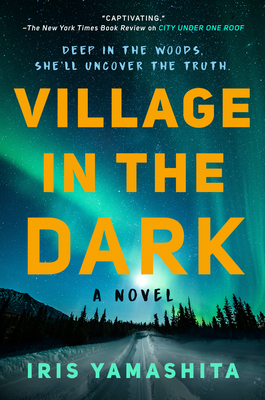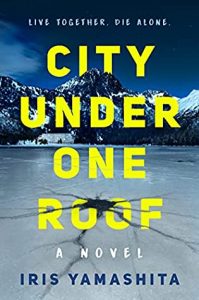 Village in the Dark (Cara Kennedy, #2) by Iris Yamashita
Village in the Dark (Cara Kennedy, #2) by Iris Yamashita Format: eARC
Source: supplied by publisher via Edelweiss
Formats available: hardcover, ebook, audiobook
Genres: mystery, suspense, thriller
Series: Cara Kennedy #2
Pages: 288
Published by Berkley on February 13, 2024
Purchasing Info: Author's Website, Publisher's Website, Amazon, Barnes & Noble, Kobo, Bookshop.org, Better World Books
Goodreads
Detective Cara Kennedy thought she’d lost her husband and son in an accident, but harrowing evidence has emerged that points to murder--and she will stop at nothing to find the truth in this riveting mystery from the author of City Under One Roof.
On a frigid February day, Anchorage Detective Cara Kennedy stands by the graves of her husband and son, watching as their caskets are raised from the earth. It feels sacrilegious, but she has no choice. Aaron and Dylan disappeared on a hike a year ago, their bones eventually found and buried. But shocking clues have emerged that foul play was involved, potentially connecting them to a string of other deaths and disappearances. Somehow tied to the mystery is Mia Upash, who grew up in an isolated village called Unity, a community of women and children in hiding from abusive men. Mia never imagined the trouble she would find herself in when she left home to live in Man’s World. Although she remains haunted by the tragedy of what happened to the man and the boy in the woods, she has her own reasons for keeping quiet. Aided by police officer Joe Barkowski and other residents of Point Mettier, Cara’s investigation will lead them on a dangerous path that puts their lives and the lives of everyone around them in mortal jeopardy.
My Review:
Just as once-and-future Anchorage PD Detective Cara Kennedy wrapped up the murder cases at Point Mettier in City Under One Roof, a monkey wrench was thrown into the case nearest and dearest to her heart. Cara has been, honestly not surprisingly, unwilling to let the case of her husband’s and her son’s deaths go, to the point where the Anchorage PD’s psych evaluation put her out on disability.
Not a good place for a detective with nothing to do but dwell on the ‘might have beens’ to be. Particularly not when a picture of her late husband, her dead son, and herself, taken just before the ill-fated trip that left her a widow, was found on the cell phone of one of the gang members responsible for the deaths in Point Mettier in that first adventure.
Making Cara in this second mystery the equivalent of a dog with a very large bone to chew on. A bone that is made just that much bigger when she has her family’s bodies exhumed and discovers that, whoever they are, and whatever the Anchorage PD told her, the bodies she buried under her husband’s and son’s names were not, in fact, the bodies of her husband and son.
Although it certainly looks like one of those bodies was the victim of murder. Adding yet more questions to the pile of unanswered ones that she already has. And not just questions about who the now unidentified bodies were, and who are the other missing, presumed dead people in that gang member’s cell phone photo roll.
Because if the two bodies she buried weren’t her own loved ones, then where the hell are her husband and her son? Are they dead by some other misadventure lost in some other remote part of the Alaskan Bush? Or are they alive and in hiding?
Or worse, does her husband have something to do with the long list of missing and presumed dead faces in that photo roll? Cara can’t rest until she finds out the truth – whether it sets her free or gets her killed. Or both, not necessarily in that order.
 Escape Rating B: Part of what made City Under One Roof work so well was the claustrophobic nature of its setting. Whittier, like the city modeled after it in the story, really is a city under one roof. That a significant chunk of that first story takes place while Point Mettier is literally cut off from the rest of the world – as really does happen in Whittier – gives the story a kind of ‘locked room’ vibe, complete with time running out as the tunnel will eventually open and the bottled up suspects will have the opportunity to escape.
Escape Rating B: Part of what made City Under One Roof work so well was the claustrophobic nature of its setting. Whittier, like the city modeled after it in the story, really is a city under one roof. That a significant chunk of that first story takes place while Point Mettier is literally cut off from the rest of the world – as really does happen in Whittier – gives the story a kind of ‘locked room’ vibe, complete with time running out as the tunnel will eventually open and the bottled up suspects will have the opportunity to escape.
The story in Village in the Dark spreads itself out in both time and space, as the action shifts from Point Mettier to Mia’s temporary refuge outside Willow to Anchorage and back again. It’s also a bigger story, in that it begins with Cara’s seemingly never-ending quest to find out what really happened – or who really happened – to her husband and son but loops in one of Point Mettier’s more colorful residents, that woman’s search for the events that led to her own son’s death, and then seemingly tacks on one mysterious young woman attempting to hide in plain sight.
It’s a bigger story but it’s a whole lot less tight and taut in the way that City Under One Roof was, and that mysteries are at their best. In other words, I got lost a bit whenever we switched to young Mia’s point of view because she started out WAY out there compared to the central axis of the story. Not that she didn’t finally move to the center of things, but it certainly took a while.
In the end, it’s a story about drugs and money. About corruption and temptation and dirty deeds done dirt cheap in the service of people who will never pay the price for the deeds done in their name – even if that name is a false one hidden behind multiple go-betweens.
But the further the story spread out, the less it hung together until the rapid-fire denouement. And then it was, quite literally, gangbusters.
At the end, the story that brought Cara into this series has been resolved. Whether it will be the jumping off point for more, and less personal and more procedural investigations, is a mystery yet to be solved.
One final note, the subtext in this entry in the series is the ease with which the police dismiss missing persons cases and crimes against women, particularly, in the Alaskan setting, indigenous women. The same horrifying subtext also underlaid the suspense in last year’s The Way of the Bear by Anne Hillerman. Coincidentally, or perhaps a commentary on the pervasiveness of the issue, the book I am currently listening to, Glory Be by Danielle Arceneaux, has an entirely too similar tragedy at its heart, yet again exploring and decrying the ease with which police discount and dismiss crimes against black women in that book’s Louisiana setting.
The pervasiveness of this all too real problem is considerably more chilling than the suspense in ANY mystery.














